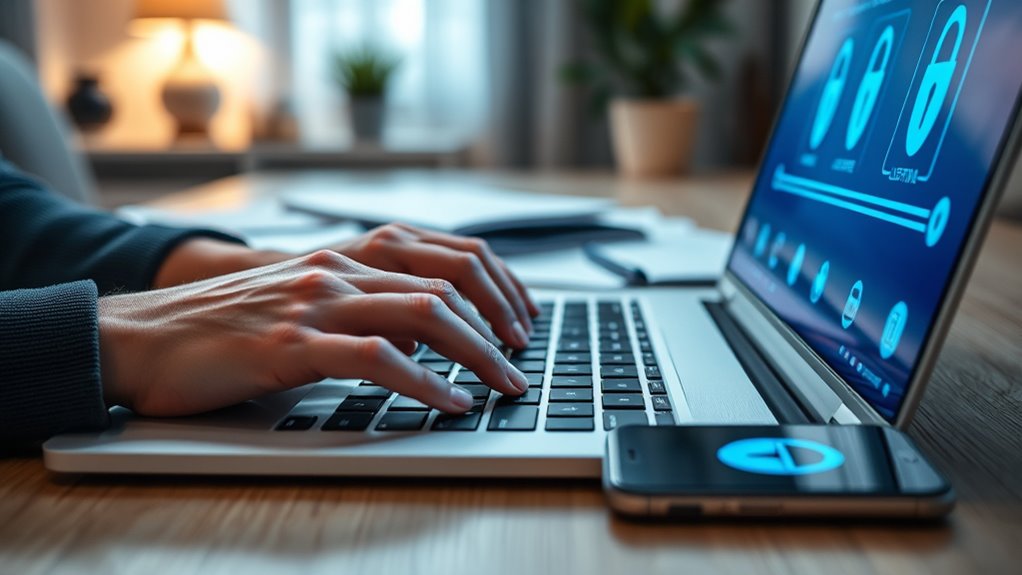To protect yourself from identity theft, use strong, unique passwords and enable two-factor authentication on your accounts. Avoid sharing personal details on social media and think twice before posting sensitive information. Shred bills and documents with personal data before disposal, and only shop on secure websites. Keep your devices updated with the latest security patches and stay alert for phishing scams. Following these steps can greatly reduce your risk—keep exploring for more tips to stay protected.
Key Takeaways
- Use strong, unique passwords and enable two-factor authentication on all financial and online accounts.
- Regularly monitor bank statements and set up transaction alerts to identify unauthorized activity early.
- Shred and securely dispose of documents containing personal information like bills and credit offers.
- Limit sharing personal details on social media and adjust privacy settings to restrict access.
- Keep software, antivirus, and device security tools up to date to prevent hacking and malware threats.

Have you ever wondered how easy it is for someone to steal your personal information? It’s a frightening thought, but the reality is that identity theft is more common than you might think. Fortunately, you can take simple steps to protect yourself. One of the most effective ways is by practicing secure online banking. When you access your accounts, always use strong, unique passwords and enable two-factor authentication whenever possible. Avoid logging into financial sites on public Wi-Fi networks, which are vulnerable to hackers. Regularly monitor your bank statements and transaction alerts to catch any suspicious activity early. These precautions make it much harder for cybercriminals to access your financial information. Incorporating vigilant security habits, like updating your software and being cautious about phishing attempts, further enhances your defenses.
Practice secure online banking with strong passwords and two-factor authentication to protect your financial information from cyber threats.
Another vital step is shredding sensitive documents. Many people underestimate how much information can be gleaned from discarded papers. Personal details like your Social Security number, bank account numbers, or even your address can be used to impersonate you if they fall into the wrong hands. Always shred bills, bank statements, pre-approved credit card offers, and any documents containing personal data before discarding them. This prevents dumpster divers or identity thieves from collecting your information easily. Keep in mind that even seemingly harmless documents, like medical bills or insurance forms, can be exploited if not properly destroyed.
Beyond these, it’s also wise to safeguard your personal information online. Be cautious about sharing too much on social media, as cybercriminals often scour these platforms for clues about your identity. Use privacy settings to limit what others can see, and avoid posting sensitive details like your full birth date or address. Using secure, reputable websites when shopping or entering personal info is essential. Look for URLs that start with “https” and ensure the site has a valid security certificate. This encrypts your data and prevents hackers from intercepting it.
Additionally, keep your devices protected with updated antivirus software and firewalls. This adds another layer of defense against malware that could steal your information. Remember, your personal data is valuable, and thieves are always looking for opportunities to exploit careless habits. By practicing secure online banking, shredding sensitive documents, and maintaining good digital hygiene, you greatly reduce your risk of identity theft. Small, consistent actions can make a huge difference in keeping your identity safe and secure. Protecting yourself isn’t complicated; it just requires awareness and proactive habits. Being informed about vertical storage solutions and other organizational techniques can also help limit clutter that might contain sensitive information.
Frequently Asked Questions
How Can I Recover My Stolen Identity Quickly?
When you realize your identity has been stolen, act quickly for effective identity recovery. Contact your bank and credit bureaus immediately to freeze accounts and dispute fraudulent activity. File a report with the Federal Trade Commission and local police. Keep detailed records of all communications. These steps help with fraud resolution and speed up your recovery process. Staying proactive minimizes damage and gets your identity back on track faster.
Are Public Wi-Fi Networks Safe for Online Banking?
Think of public Wi-Fi like a crowded marketplace—easy to access but risky if you’re not careful. Public Wi-Fi risks include hackers intercepting your data, making online banking security vulnerable. It’s best to avoid conducting sensitive transactions on unsecured networks. Use a VPN or your mobile data instead. Protecting your information requires smart choices, so don’t let convenience compromise your online safety.
What Are the Signs That My Identity Has Been Stolen?
If your identity has been stolen, you might notice unexpected credit card fraud, such as unfamiliar charges on your statements. You could also find fraudulent accounts opened in your name or alerts from your bank about suspicious activity. Keep an eye out for emails or calls asking for personal info, and monitor your credit reports regularly. These signs indicate someone may be using your identity without your permission.
How Often Should I Check My Credit Report?
Did you know that nearly 1 in 5 Americans experienced identity theft last year? You should check your credit report at least once a year, but more often if you notice suspicious activity. Regular credit monitoring helps catch issues early. For ideal report timing, review your report every 3-6 months, especially if you’ve recently applied for credit or experienced a data breach. Staying vigilant keeps your financial health secure.
Can Scammers Access My Financial Information Through Social Media?
Scammers can access your financial information through social media scams if you’re not careful. They often exploit public posts or fake profiles to gather details. To protect yourself, review and tighten your privacy settings regularly, making it harder for scammers to see your personal info. Be cautious about sharing sensitive details online and avoid clicking on suspicious links, which can lead to scams or malware that compromise your financial security.
Conclusion
Just like a knight guards their castle, you must shield your personal information from lurking threats. Remember the wisdom of the Trojan Horse—things aren’t always what they seem. Stay vigilant, keep your details private, and use strong passwords. By doing so, you’ll keep your digital kingdom safe from identity thieves. Protecting your identity isn’t just a choice; it’s your modern-day armor against those who seek to breach your defenses. Stay alert and stay secure.









